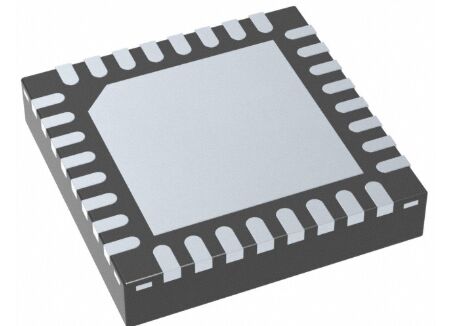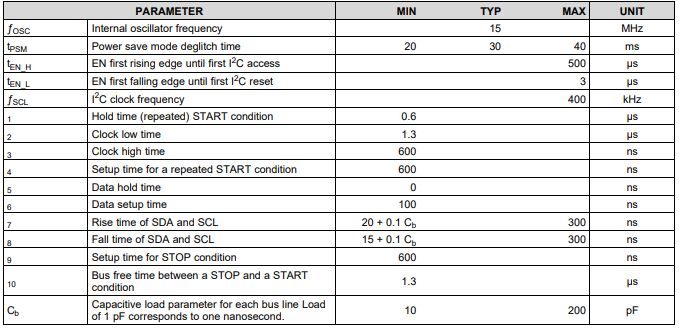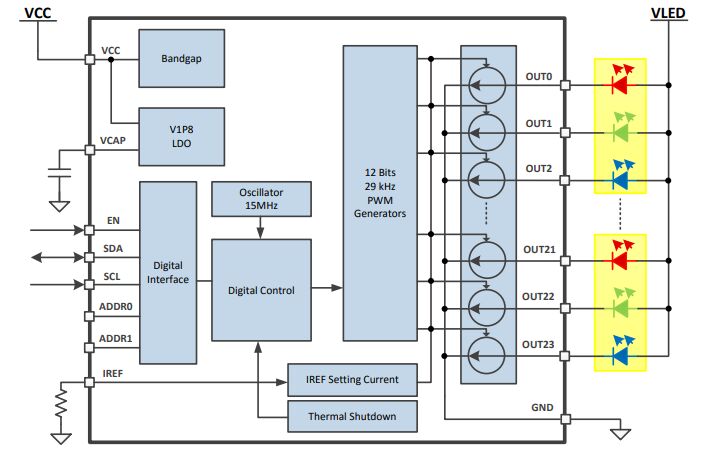By Texas Instruments 118
LP5018RSMR is a digital LED driver device manufactured by Texas Instruments. It is an integrated multi-channel LED driver that can be used to control the brightness and color of LED strips or LED fixtures. LP5018RSMR has a variety of functions and features, including digital control, PWM dimming, RGB color mixing, temperature monitoring and protection functions, etc. It typically uses an I2C interface to communicate with a microcontroller or other digital device for precise LED control.

Ⅰ.Specification parameters of LP5018RSMR
•Installation style:SMD/SMT
•Package/Box:VQFN-32
•Number of output terminals:18 Output
•Product Category:LED Lighting Driver
•Package:Reel
•Dimming:I2C
•Number of pins:32
•Humidity Sensitivity:Yes
•Output current:35 mA
•Input voltage:2.7V to 5.5V
•Topology:Boost
•Operating frequency:15 MHz
•Output voltage:5.5 V
•Input voltage (minimum):2.7 V
•Input voltage (maximum):5.5 V
•Minimum operating temperature:-40℃
•Maximum operating temperature:+125℃
•Type:Linear
•Subcategory:Driver ICs
•Part Status:Positive
•Terminal position:Square
•Lead-free code:Yes
•JESD-609 code:e4
•Multi-channel display capability:No
•Data input method:serial port
•Number of channels:18 Channel
•Type:RGB LED Driver
•Trademark:Texas Instruments
•Products:LED Lighting Drivers
•Terminal surface treatment:Nickel/Palladium/Au
•Supply Current—Max:8 mA
Ⅱ.Working principle of LP5018RSMR
LP5018RSMR is an LED driver that uses an internal PWM controller to adjust the brightness of the LED. By inputting a PWM signal, the brightness of the LED can be adjusted to achieve color change and brightness adjustment. At the same time, LP5018RSMR also supports communication protocols such as I2C or SPI to communicate with the main control chip or microprocessor to realize functions such as LED switching, brightness adjustment, and color change.
1.Digital control: LP5018RSMR accepts control signals from a microcontroller or other digital devices. These signals are usually sent over a serial interface (such as I2C) and contain instructions to control the brightness and color of the LED.
2.LED driver: The output terminal of LP5018RSMR is connected to the LED lamp. It has multiple independent LED output channels and can control multiple LEDs or LED strips. By adjusting the PWM signal of each channel, LED effects of different colors and brightness can be achieved.
3.PWM dimming: LP5018RSMR uses pulse width modulation (PWM) technology to adjust the brightness of LEDs. It generates the corresponding PWM signal according to the received control signal, and adjusts the brightness level of the LED by changing the duty cycle of the PWM signal.
4.Integrated functions: LP5018RSMR usually also has integrated current control, temperature monitoring and protection functions to ensure stable operation of the LED and protect the equipment from damage.
5.Color mixing: LP5018RSMR supports RGB color space and can achieve various colors by independently adjusting the brightness of red, green and blue LED channels. By changing the PWM signal of each channel, hundreds of colors can be mixed.
Ⅲ.Advantages of LP5018RSMR
1.LED BANK control
Most LED animation effects, such as blinking and breathing, use the same lighting pattern on all RGB LEDs. The LP5018RSMR device provides a simple coding solution called LED group control instead of operating each LED individually, which consumes a lot of microcontroller resources.
2.Automatic power saving mode
Using PWM dimming technology, LP5018RSMR can adjust the brightness of LEDs with high efficiency to achieve energy-saving lighting solutions. When all LED outputs are turned off, the LP5018RSMR device automatically enters power-saving mode, reducing idle current consumption to 10A (typ). Automatic power saving mode is enabled when register bit Power SaveEN=1 (default) and all LEDs are off for more than 30 milliseconds. In power saving mode, almost all analog blocks are turned off. The LP5018RSMR device will return to normal mode if any I²C commands are sent to it.
3.Multi-channel control
LP5018RSMR usually has multiple LED output channels, which can independently control the brightness and color of each channel to achieve complex LED effects and color mixing, such as RGB color lighting effects.
4.Flexibility and programmability
The LP5018RSMR can be programmed and controlled via a digital interface so that the brightness, color and effect of the LED can be precisely adjusted and customized according to needs. This flexibility makes it suitable for a variety of different application scenarios.
5.PWM control of each channel
High-resolution PWM generators are used only for intensity control in most conventional LED drivers built for single-color LEDs. However, to achieve the desired look using RGB LEDs, color mixing and intensity control must be handled simultaneously. In older solutions, users had to use a single PWM register to manage both color mixing and intensity control. When using logarithmic scale control, there are some undesirable effects: restricted dimming steps, difficult software design, and color distortion.
6.High integration
LP5018RSMR integrates multiple LED channels, PWM control, current control, temperature monitoring and protection functions, etc., reducing the need for peripheral devices, simplifying system design, and improving overall reliability and stability.
7.Current range setting
A single external resistor RIREF controls the constant current value (ISED) for all 24 channels. When the IREF pin is empty, the output current is close to zero. The LP5018RSMR device provides internal current limiting protection when the IREF pin is short-circuited to GND, and the maximum current of the output channel is limited to ILIM.
8.Long life
Using high-quality LED and driver chips, it has a long life and reduces the frequency and cost of maintenance and replacement.
9.Constant current drive
LP5018RSMR adopts a constant current driving method, which can ensure the brightness of each LED is consistent and avoid uneven brightness.
10.Reliability and security
LP5018RSMR has built-in temperature monitoring and protection functions, which can monitor the operating temperature of the LED and take protective measures when it exceeds the safe range to prevent the LED from being damaged by overheating, improving the reliability and safety of the system.
11.Protection Features-Thermal Shutdown
The thermal shutdown feature in the LP5018RSMR gadget protects the device from damage caused by overheating. When the junction temperature reaches 160°C (typ), the device enters shutdown mode. When the junction temperature of the LP5018RSMR device drops to 145°C, the device releases thermal shutdown (typ).
Ⅳ.Absolute Maximum Ratings of LP5018RSMR
over operating temperature ambient range (unless otherwise noted)

Ⅴ.Timing Requirements of LP5018RSMR
over operating temperature ambient range(-40°C<TA<85°C) (unless otherwise noted)

Ⅵ.How to configure LP5018RSMR to achieve specific LED effects?
1.Connect the hardware: First, correctly connect the LP5018RSMR to the LED fixture or LED strip. Ensure that the power supply meets specifications and that the LEDs are properly connected to the LP5018RSMR's LED output channels.
2.Initial setup: Use a microcontroller or other digital device to communicate with the LP5018RSMR through the I2C interface. Send initialization setting commands, including setting the number of LED channels, PWM frequency, brightness control mode, etc. Make sure the LP5018RSMR is in the correct operating mode and enabled.
3.Set the LED effect: Configure the LED channel of LP5018RSMR according to the required LED effect. You can first set the brightness, color, and effects of each channel by sending specific commands. For example, if you want to achieve RGB color lighting effects, you can set the brightness of the red, green, and blue channels separately to mix the desired colors.
4.Adjust parameters: Adjust the parameters of LP5018RSMR to optimize the LED effect. Parameters such as brightness levels, color saturation, gradient effects, etc. can be adjusted to meet the requirements of specific applications.
5.Testing and debugging: After the configuration is completed, test and debug to ensure that the LED effect is as expected. Fine-tune and optimize as needed until you achieve satisfactory results.
6.Application integration: Integrate the LP5018RSMR into the target application and ensure that it works properly with other system components. Ensure correct connections for power, communications, and control, and perform final verification and testing.
Ⅶ.Dimming method of LP5018RSMR
1.Linear dimming: In LP5018RSMR, linear dimming can be achieved through analog input signals. By changing the voltage or current of the analog signal, the brightness of the LED can be adjusted linearly to achieve smooth brightness changes. This dimming method is suitable for scenes that require continuous brightness adjustment, such as gradient lighting, gradient special effects, etc. When using linear dimming, you need to pay attention to the voltage and current range of the LED to avoid over-modulation leading to LED damage or performance degradation.
2.PWM dimming (Pulse Width Modulation): This is one of the most commonly used dimming methods of LP5018RSMR. PWM dimming controls the brightness of the LED by changing the proportion of the LED's power-on time. In a cycle, the longer the power-on time of the LED, the higher the brightness; the shorter the power-on time, the lower the brightness. LP5018RSMR can adjust the brightness of LED according to the input PWM signal to achieve flexible dimming effect.
3.Gradient dimming: LP5018RSMR also supports gradient dimming function, which achieves a smooth gradient effect by gradually changing the brightness of the LED. This dimming method is often used to create soft light transition effects, such as sunrise and sunset simulations.
4.Amplitude Modulation: Amplitude modulation is a method of adjusting LED brightness based on changing the amplitude of the dimming signal. LP5018RSMR can accept amplitude modulation dimming signals and adjust the brightness of LED according to the amplitude of the signal.
Ⅷ.Application fields of LP5018RSMR
1.Commercial lighting: LP5018RSMR has a wide range of applications in the field of commercial lighting. By using LP5018RSMR, the brightness and color of LED lights can be flexibly controlled to achieve various creative lighting effects. For example, the brightness of LEDs can be adjusted to create different atmospheres such as warmth, romance, and dynamics, or RGB LEDs can be adjusted to create colorful visual effects.
2.Home lighting: LP5018RSMR can be used in home lighting systems, such as LED lamps, chandeliers, table lamps and wall lamps, etc. Through the dimming and color control functions of LP5018RSMR, lighting effects of different brightness and colors can be achieved to improve living comfort.
3.Stage lighting: LP5018RSMR can be used to control stage lighting and stage effects. It can adjust a variety of colors, brightness and dynamic effects, providing colorful lighting effects for performances and events. By using LP5018RSMR, you can flexibly control the color, brightness and dynamic effects of LED lights to create rich and diverse stage effects.
4.Automotive lighting: In automotive interior and exterior lighting systems, LP5018RSMR can be used to control car lights, dashboard lights, ambient lights and interior lighting, etc. Through the dimming and color control functions of LP5018RSMR, personalized interior lighting effects can be achieved, improving the quality and comfort of the vehicle.
5.Electronic display: In LED displays and display modules, LP5018RSMR can be used to control the brightness and color of the display backlight. It can achieve high-precision dimming and color calibration, improving the image quality and look and feel of the display.
6.Decorative lighting: In indoor and outdoor decorative lighting projects, LP5018RSMR can be used to control LED light strips, light strings, decorative lights and landscape lighting, etc. It can achieve various dynamic effects and color changes, enhancing decorative effects and visual appeal.
Ⅸ.Function modules of LP5018RSMR

Frequently Asked Questions
1.What is the function of LP5018RSMR?
LP5018RSMR is a digital LED driver with color control, LED control, gradient effect, multi-channel output, digital interface and other functions.
2.What type of interface does LP5018RSMR use for communication?
LP5018RSMR typically uses an I2C interface for communication with a microcontroller or other digital devices. This allows users to send commands to configure the LP5018RSMR's settings and control LED operations.
3.What are the main features of LP5018RSMR?
The main features of LP5018RSMR include multiple LED channels with individual brightness control, PWM dimming support, RGB color mixing capability, temperature monitoring, and protection features such as overtemperature and overvoltage protection.